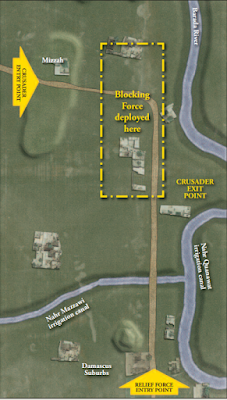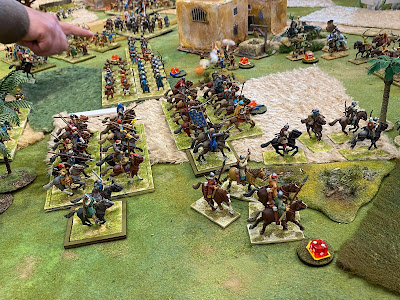INTRODUCTION
Last week, we played in our club “La Piccola Armata”: the Battle of the Barada … better known as the first day of the "potential" siege of Damascus.
We used Hail Caesar published by Warlord Games, deploying around 500 minis in 28mm scale on a 300 cm x 180 cm table.
The scenario was prepared by Ezio and was taken from one of the introductory scenarios in the basic rulebook.
HISTORICAL SCENARIO
The Battle of Barada is part of the Second Crusade and was fought near Damascus on July 24, 1148.
In 1144, the County of Edessa, the first Crusader state in the Holy Land, had fallen to Imad al-Din Zengi, founder of the Zengid dynasty. King Louis VII of France and Conrad III of Germany decided to reconquer the city.
The two monarchs, who moved separately, crossed Europe towards the Holy Land. After reaching Constantinople the two armies joined forces at Lopardium and then moved east.
Once in Jerusalem, Luois and Conrad met King Baldwin III and Patriarch Fulcherio, changing their initial plans.
Since Edessa had been lost and retaken twice, it was in no condition to be retaken. So, it was decided to launch an attack against Damascus. A city which, until that moment, had been one of the Crusaders' allies.
The combined Crusader forces marched northeast towards Damascus. Having reached the fertile and irrigated suburbs, they turned north to cross the Barada River, circumnavigating the solid city walls. A force of militia and local Turkoman tribes tried to stop the crusaders amid low walled orchards, narrow roads and riverside irrigation ditches…our story begins here …
THE DEPLOYMENT
The Crusader army includes 3 generals and 3 commanders divided over three contingents. The contingent of the Latin States under the command of King Baudouin III, the French contingent of King Louis VII and the German one of King Conrad III.
The Damascus army deploys 1 general and 7 commanders divided into a main force (2 divisions) and a support force (6 divisions).
My club mates split into the various commands. Ezio, Marco, Riccardo and Rodolfo army of Damascus; Nevio, Giancarlo, Luciano and Simone crusader army.
Baldwin III's contingent deploys at the top of the hill near the village of Mizzah. The French and, then the German contingent enter, during the 1st turn with a test behind Baldwin's contingent.
Map from Hail Caesar rule book all copyrights reserved
The blocking force of Damascus is positioned on the banks of the Barada river. One of the divisions from the support force is already deployed by the player in march column on the road to Damascus.
The other divisions enter from the 2nd round onwards with a test at 4+
The objective of the crusaders is to pass at least 15 units across the Barada river. Muslims must prevent this. Routing the enemy army is considered a victory.
THE BATTLE
During the first turn, Crusader players attempt to move as quickly as possible towards their objective but a series of failed tests cause movement to slow down. Only the French contingent enters in this turn.
The Muslim support column moves along the roads to flank the Crusaders
Muslim main force haunts enemies with bows, trying to slow them
During the second and third turns the Crusaders attack with bows and crossbows. King Louis moves to the left flank of the formation to intercept the support columns. Conrad and his Germans arrive on the battlefield.
On the Crusader left flank, the Turcopoles and Baldwin III's Knights Templar manage to push away the enemy light cavalry and approach the river.
Muslim main force holds off Crusader attack while support columns move quickly but, one of the divisions, is forced by a failed test to become stuck crossing an irrigation ditch
In the fourth and fifth rounds all Muslim support divisions enter the field
Baldwin and his knights push away the Arab light cavalry and arrive near the river. They try to threaten the enemy right flank
The Germans and Baldwin's infantry also move towards the river
On the right flank of the Crusader deployment, King Louis lined up in defense trying to intercept the incoming Muslim troops.
The clash, in the following rounds, is concentrated in the suburbs of the village of Mizzah. Baldwin and the Templars charge many times the Muslim infantry and the support columns trying to screen the infantry that is going towards the river.
On the Crusader right flank, King Louis and his contingent fight against the support columns in an attempt to buy time for the rest of their army
The battle, after almost 7 hours of play, ends with a Saracen victory. Crusaders lose two cavalry divisions and fail to cross the river, only one cavalry unit reaches the objective. Even the army of Damascus sees the destruction of two divisions: one of infantry and one of cavalry, those of the main force.
BETWEEN HISTORY AND GAME
The Crusaders, constantly bombarded by arrows and spears, laboriously pass through the narrow paths of the cultivated fields. Only thanks to a charge by Conrad III the crusaders open the way and drive back the Muslim attackers beyond the Barada river.
Arrived under the walls of Damascus, they use the wood from the orchards to build a defensive perimeter. Attacked several times, on 27 July, the Crusaders retreated to the east of the city. Area less fortified but with less supplies of food and water.
Among the ranks of the Crusaders, discussions begin about who will control Damascus after conquering it. Meanwhile, the Muslim reinforcements commanded by Nur ad-Din and Sayf al-Din approach Homs and on July 28 the Crusaders leave the field to return to Jerusalem.






















Lovely looking game!!
RispondiEliminaA beautiful looking game gents. Bravo!
RispondiEliminagreat stuff
RispondiEliminaLovely looking game!
RispondiEliminaChristopher
Questo commento è stato eliminato dall'autore.
Elimina